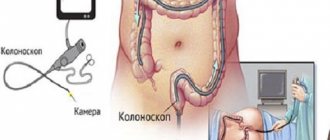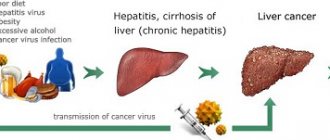Colostomy is a surgical intervention that consists of creating an artificial opening that will perform the functions of the anus (ensure adequate passage of intestinal contents and gases). The course of the operation involves bringing out a section of the colon and suturing it to the tissues of the anterior abdominal wall. The stoma can be temporary (subsequently it is planned to stitch together the removed segments) or permanent (it is the final stage of surgical treatment). This operation is most widely used in oncology.
Indications
Colostomy is a serious and difficult surgical intervention, which can subsequently bring significant inconvenience to the patient, as it requires the constant use of a colostomy bag. This method in surgery is used in extreme cases when there is no other alternative.
Diseases and pathological conditions for which a colostomy is performed:
- extensive inflammatory damage to the rectum and colon after radiation therapy for pelvic cancer;
- severe ulcerative-necrotic lesions of the lower parts of the large intestine, not amenable to drug treatment;
- extirpation of the rectum and anal sphincter;
- traumatic injury to the large intestine;
- fecal incontinence that cannot be treated by any other means;
- inoperable neoplasm of the intestine or pelvis, which led to intestinal obstruction (palliative measure);
- the presence of enterovesical or enterovaginal fistulas (a colostomy is performed for the period of treatment);
- intestinal obstruction, if it is impossible to immediately restore the integrity of the intestinal tube (a temporary stoma is created).
Reviews and results
The nutrition of the main table is balanced and this allows you to use it constantly without intestinal discomfort. According to patient reviews, it sometimes took 3-4 weeks to create an optimal diet. There are also certain difficulties associated with individual cooking. However, many people constantly adhere to it and do not consider themselves disadvantaged in any way.
- “... I had colon cancer, the tumor was removed and a stoma was formed. After 4 months, reconstruction surgery was performed. While I was with her, the food was normal, with the exception of rough, fried and junk food. After closing the hole, the power changed. In the first month, the doctor recommended eating everything pureed, ground and soft. Mostly there were soups, minced meat, pureed porridge. It was forbidden to eat apples, fresh vegetables and fruits, as well as grapes. Only after 1.5 months I began to try soft fresh fruits, and after 4.5 months I was already eating everything. True, the process of selecting products was difficult. Now everything is fine, I go to the doctor every six months”;
- “... After the tumor was removed, my mother had a colostomy, and after two months she could have reconstructive surgery. Now he is constantly on a diet, especially the first 3 months, since the non-functional intestine took a long time to recover. There was constipation, and with more vegetables, it became weaker. At this time, I tried to eat only boiled and steamed food, and new dishes were introduced gradually in small portions. Thus, within a month we found foods that were acceptable for her and finally created a diet.”
Contraindications
This surgical intervention is considered unjustified:
- if it is possible to perform a sphincter-preserving operation (to be able to preserve the physiological act of defecation);
- in patients with advanced cancer, when intestinal obstruction can be eliminated by partial excision of the tumor;
- if there are concomitant diseases in the stage of decompensation.
Also, when assessing the risks of surgery, the possibility of developing the following complications should be taken into account:
- abscess and inflammation of the colostomy and adjacent tissues;
- postoperative hernias;
- necrosis of part of the intestine;
- stoma retraction (retraction);
- scarring and formation of intestinal stricture.
Rules for gluing colostomy bags
Each colostomy bag has a special stencil for measuring the stoma opening. If there is no such ruler, you can use a transparent film, which must be placed over the mouth and traced around the edges with a pen, then cut out this hole in the film, put it on paper, outline the edges of this oval and cut out the hole. A hole 2-3 mm larger than the size of the mouth is cut out on the adhesive plate of the colostomy bag. It is necessary to glue it with smoothing movements after slightly warming it up and removing the protective film from bottom to top so that the retainer is on top to facilitate further removal.
View gallery
If the colostomy bag is equipped with a drainage bag, it must be emptied after the bag is one third full. This can be done over the toilet by opening the drainage hole, then rinsing and drying the stool bag. After treatment, do not forget to close the drainage hole.
Varieties
There are the following types of colostomy:
- double-barreled colostomy (loop);
- double-barreled separate;
- single-barrel (end).
A double-barreled (loop) colostomy involves bringing both the adducting and efferent segments of the intestine onto the anterior abdominal wall. In this case, complete separation of the intestine does not occur (only the anterior semicircle of the wall is dissected). This type of colostomy is used as a temporary measure.
When forming a double-barreled separate colostomy, as with a loop colostomy, both segments of the intestine are brought out onto the anterior abdominal wall. The difference is that in this case the surgical technique involves complete separation of the intestine (the afferent and efferent sections are removed separately).
A single-barrel (end) colostomy is formed from an afferent loop. In this case, the distal segment is tightly sutured. This method is used to form a permanent unnatural anus.
The surgeon individually determines what type of colostomy is indicated in each specific case.
Closing the colostomy during the operation. Colostomy surgery
Unlike an ileostomy, a colostomy is an opening for removing feces from the large intestine.
A colostomy has some advantages over an ileostomy:
- Although uncontrollable, the urge to defecate is an opportunity to mentally prepare in a few minutes.
- The feces are practically formed - the skin around the stoma is subject to less irritation.
- The course of the operation to apply a colostomy, just like the course of the operation to close it, consists of fewer stages.
- The diet is not so strict.
- The recovery period takes 2-3 times less time than if a stoma for the small intestine is closed.
The course of the operation to close a colostomy consists of the following stages:
What is a colostomy and what you need to know about it
- With a double-barreled stoma, an incision is made between two holes, and with a single-barrel stoma, the length of the incision depends on the length of the longitudinal incision of the colon, which was made before the colostomy.
- The section of intestine where the ostomy was performed is removed.
- With double-barrel, the holes are sutured, and with single-barrel, the functioning ends of the intestine are connected. As a rule, the closure of an end stoma (single-barrel type) is carried out with the removal of a section of the intestine that was cut longitudinally, plus 10-15% beyond this length, and this is already a resection of the intestine, that is, the intestine will not function as before the ostomy. The consequences are expressed in rapid bowel movements from 15 minutes to 2 hours after eating. Accordingly, in order to increase the absorption of nutrients, you need to either eat several times more, or switch to high-calorie and frequent meals 5 times a day or more. Therefore, the procedure for closing a double-barreled stoma is easier for the surgeon and the patient than the operation for closing a single-hole stoma.
- The muscle tissue is carefully sewn together and the top suture is applied. Sutures are applied with self-absorbing threads such as catgut.
- The degree of tightness of the intestinal section is checked.
How is the operation performed?
In almost all cases, the formation of a colostomy is one of the stages of another, more extensive surgical intervention (resection of part of the intestine, elimination of intestinal obstruction). The operation can be carried out in different ways:
- laparotomy (open);
- laparoscopic (using video equipment).
The type and technique of colostomy is determined by the attending physician, taking into account the type of pathology, its volume and the degree of intestinal damage. Also, the price for providing this service will depend on the method of carrying out the operation.
Stages of surgery:
- The anesthesiologist performs endotracheal anesthesia.
- Access is provided to the desired area of the large intestine (depending on the location of the pathological process).
- If the operation is performed laparotomically, then one large incision is made and the surgeon performs all manipulations under control.
- If the laparoscopic method was chosen, then several small incisions are made through which special surgical instruments and optical devices are inserted, and the image is displayed on the monitor (this method is more gentle, but in some cases cannot be used). The location of the colostomy on the anterior abdominal wall also depends on which area was accessed and which part of the large intestine was operated on.
- The main stage of the operation is performed (removal of part of the intestine, extirpation of the rectum, etc.).
- The incision for subsequent colostomy formation is made separately from the main laparotomy incision. The skin at the site of the colostomy should be free of scars and inflammation. A layer-by-layer dissection of the tissue is carried out, then the surgeon sutures the parietal peritoneum to the tissues of the aponeurosis and muscles.
- Through the created hole, a loop of intestine is brought out into the wound and intersected (it may already be dissected if the stoma was preceded by an operation to resection part of the intestine).
- A colostomy is formed from the proximal end of the loop by suturing the intestine to the skin and aponeurosis. The intestinal wall should not be compressed too much by the edges of the incision, since excessive compression can lead to disruption of the blood supply and necrosis of part of the intestine.
- If an end stoma is planned, the diverting loop is sutured tightly and immersed back into the abdominal cavity.
- At the last stage, the surgeon closes the incision through which the main access was made layer by layer.
The first days after the stoma is closed. How does surgery to close a colostomy work?
A colostomy is an artificially created opening in the large intestine that allows stool to pass out. It is applied in various cases: for problems with the lower intestines, for malignant neoplasms and other factors. Colostomy can be either temporary or permanent.
The operation to close a temporary colostomy is called reconstructive surgery and is the elimination of a previously created stoma.
The operation is performed by a qualified and experienced surgeon and takes place within one hundred to one hundred and twenty minutes. In some cases, the operation lasted up to three hours. Sometimes the elimination of a colostomy occurs in two stages, the interval between which is several days. This operation is performed under general anesthesia, and if the patient’s heart is not able to cope with general anesthesia, then the colostomy is not closed until his heart can cope with such a load.
This method of surgical intervention consists of several stages.
If a double-barreled stoma was applied, then an incision is made between the holes; with a previously applied single-barrel colostomy, the length of the incision directly depends on the longitudinal incision of the colon.
After the incision, the section of the intestine where the ostomy was performed is removed.
With a single-barrel colostomy, the two ends of the intestine are connected, and with a double-barrel colostomy, the holes are simply sutured. When closing an end stoma, it is most often accompanied by the removal of that section of the intestine that was cut longitudinally. It turns out that the intestines will no longer function as before. The most striking consequence of this is rapid bowel movement, which lasts from fifteen minutes to two hours from the moment of eating. Therefore, to increase the digestibility of foods, you need to eat several times more, but for these purposes, the method of fractional meals is most often used. That is, they eat often, but in small portions. Thus, the operation to close a double-barreled stoma is easier for both the patient and the surgeon who performs it than the closure of an end stoma with a single opening.
Then the muscle tissue is sewn together, and then the upper sutures are applied using self-absorbing threads. Lastly, the intestines are checked for leaks. Such an operation may also contain additional stages when, for example, a rectal lobe transplant is required.
Colostomy care
The rehabilitation period is difficult for patients, as it becomes necessary to constantly wear special containers for collecting intestinal contents - colostomy bags. This brings psychological discomfort to patients, so it is necessary to explain to the patient even before the operation that it is possible to work with a colostomy bag and lead a full social life.
The diet of a patient with a colostomy should be designed in such a way as to prevent constipation, diarrhea and excessive gas formation. With a properly selected diet, there should be no digestive disorders or loss of appetite.
The colostomy bag should be changed as it fills (1-2 times a day). Before attaching the colostomy bag, you must thoroughly wash and degrease the skin. If there is pronounced hair growth, the hair must be shaved to ensure reliable fixation of the colostomy bag. If any rashes or redness appear on the skin around the stoma, you should immediately consult your doctor.
Colostomy is a radical and psychologically difficult operation for the patient. However, with qualified implementation of the intervention and timely provision of preventive psychological assistance, it is possible for the patient to quickly recover in the postoperative period and minimize the unpleasant consequences associated with the manipulation.
What can you eat
The food after the ostomy is closed is varied and tasty if you correctly arrange the permitted products in the menu and use various recipes for their preparation.
What can be consumed after the closure of the intestinal stoma: various cereals, first in pureed form, after restoring the activity of the digestive system - in non-mashed form. Soups are allowed with vegetable broth or broth made from lean meats. The bread is only yesterday's bread, dried, baked from wholemeal flour.
Vegetables - any that do not cause gas, boiled or baked, or cooked in puree: zucchini and cabbage, beans, dill, carrots and potatoes.
Fruits: quince and pomegranate, pears, oranges, dogwoods, apples.
On this topic
- Digestive system
Differences between sigmoidoscopy and colonoscopy
- Natalya Gennadievna Butsyk
- December 9, 2020
Meat dishes - meatballs, cutlets, rolls, are prepared from lean meats and only steamed. Poultry meat – chicken, turkey. Rabbit meat, beef and veal are allowed.
Fermented milk products must be present in the diet: low-fat yogurt and kefir, sour cream, low-fat cream. Milk is recommended to be consumed only as an additive when preparing dishes.
Cereals cooked in water or milk: buckwheat, rice, oatmeal, semolina.
For sweets: hardened biscuit, dry, low-fat cookies, marshmallows, marshmallows, fruit marmalade, and jam are allowed.
After the stoma is closed, it is allowed to introduce pasta and noodles into the diet.
Drinks: preference should be given to decoctions that have a positive effect on peristalsis, for example, a decoction based on rose hips; fruit drinks are allowed. Juices – apple, cherry, pumpkin, always diluted with water. The use of cocoa prepared with water is allowed.
The menu for closing an intestinal stoma allows the use of boiled, soft-boiled, or hard-boiled eggs, or in steamed omelettes, but their quantity should not be abused. Eggs are consumed in quantities of 1-2 at a time, every other day.
The list of permitted foods when closing an intestinal stoma is generalized. Each patient selects those products that have a beneficial effect on peristalsis, since situations are possible when a person has an individual reaction to an approved product.
How to care for your stoma?
With a colostomy, i.e. removing a section of the large intestine onto the abdominal wall, the shape and appearance of feces will differ little from usual, the frequency of stools is usually 2-3 times a day. In the first time after surgery, when the person is still in hospital conditions, the stoma is cared for by medical personnel. This process consists of timely removal of feces, treating the wound with disinfectant solutions, and applying a gauze bandage. Subsequently, the doctor or nurse teaches the patient or family member about self-care.
Once the wound has healed, colostomy bags can be used. Colostomy bags are special bags for collecting stool. Colostomy care is mainly performed while changing the colostomy bag. With each replacement you must:
- First make a hole in the colostomy bag that matches the size and shape of the stoma.
- Remove the filled colostomy bag: depending on the type, it can be removed completely or partially.
- Rinse the skin around the stoma with plain water and remove dirt. To clean the stoma, there are also cleaners that help to perform care without water, disinfect, and also prevent dry skin (for example, “Cleancer”.) After cleaning, dry the skin with napkins or a soft towel, if necessary.
- If necessary, use protective creams and films to protect the skin from excessive moisture, as well as to restore damage (Barrier cream, protective film, protective powder).
- To create a smooth surface and improve the fit of the colostomy bag, apply a special paste (Comfil in a tube or in strips, Stomagesiv).
- Using the instructions, secure the new colostomy bag.
Proper nutrition for patients with colostomy
There are no special restrictions on the intake of certain products. However, it should be remembered that it is better to avoid foods that cause liquefaction of stool or contribute to a decrease in intestinal motility: white bread, rice water, tea, cocoa, some fruits and vegetables, etc. To stop the unpleasant odor from the colostomy, you should not abuse onions, garlic, or alcohol , boiled eggs. Food must be consumed frequently and in small portions. After surgery, you should gradually expand your diet and switch to normal nutrition.











